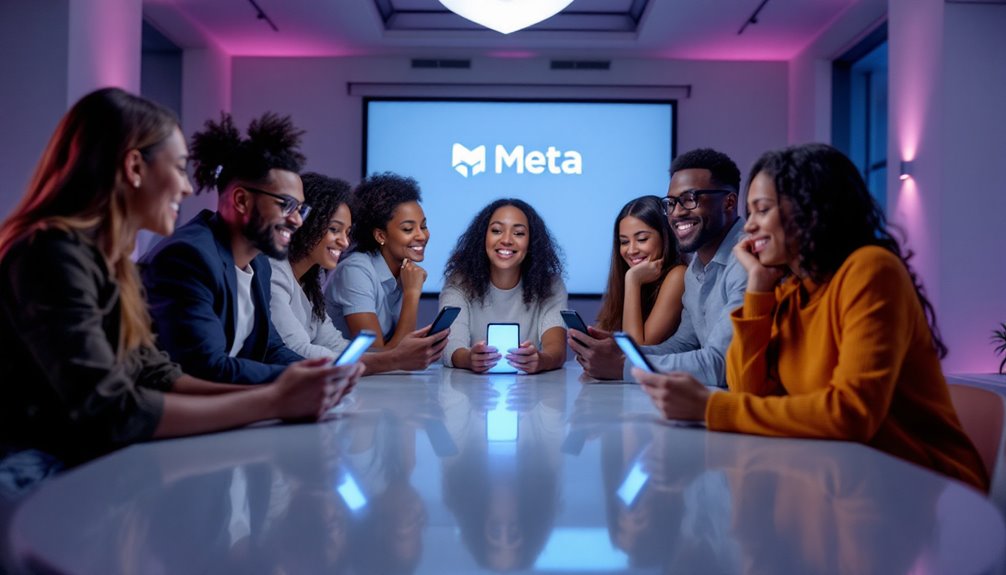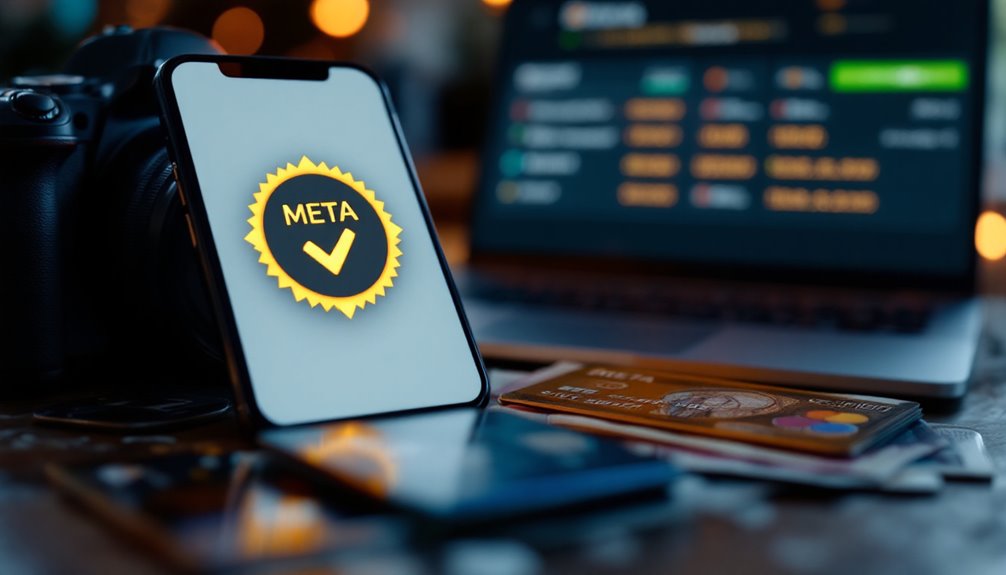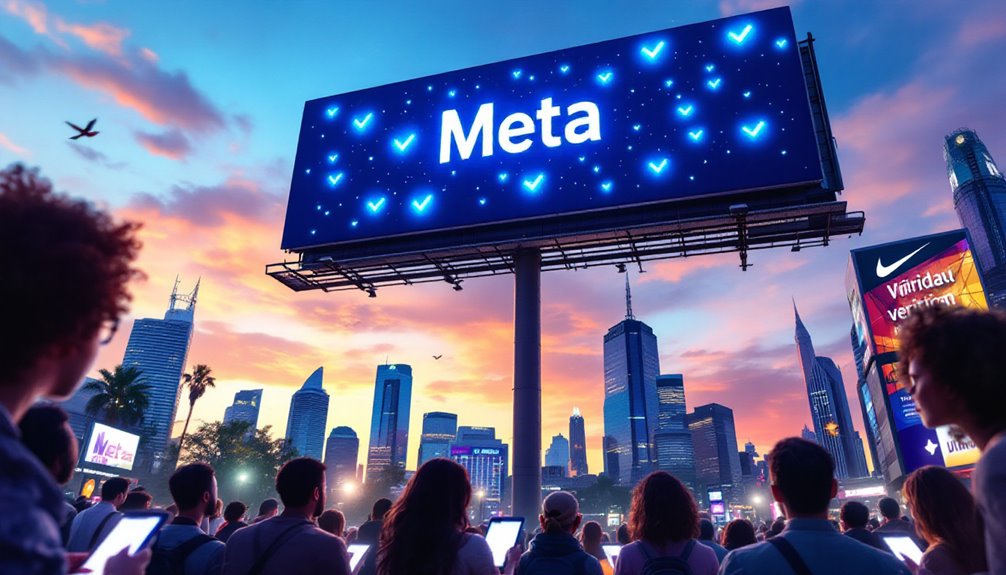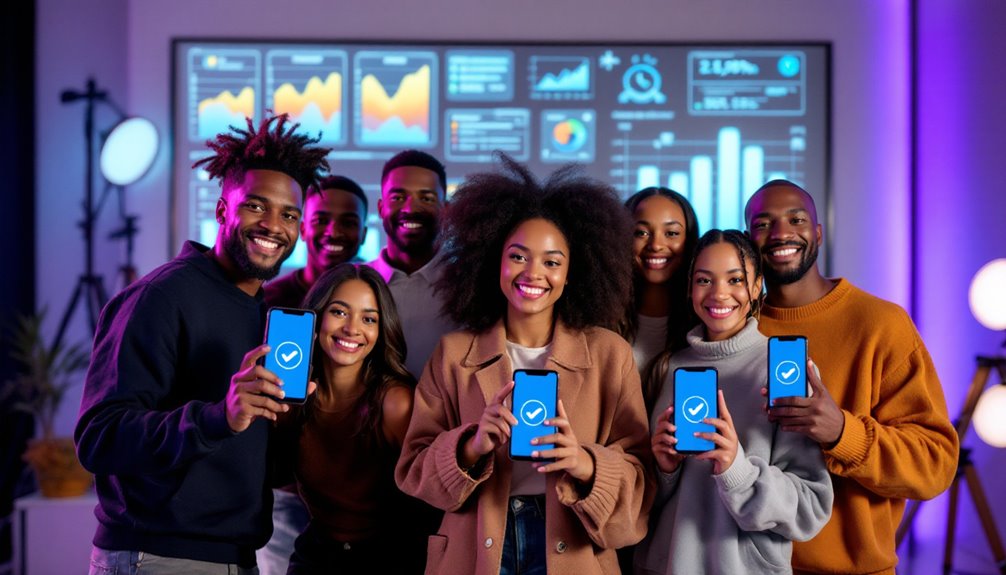
Did you know that less than 10% of social media users are Meta Verified? You might be wondering why so few achieve this status. It's not as simple as just applying; there are specific criteria you must meet. You'll need to verify your identity with a government-issued ID and show your account's notability. Curious about what makes an account notable or the advantages of being verified? Let's explore the intricacies of Meta Verification.
Key Takeaways
- Meta Verified requires identity verification with a government-issued ID and a significant public presence.
- Only one account per person or business is eligible; the profile must be complete and public.
- Applicants must be at least 18 years old and live in a country where verification is available.
- Subscription costs vary and separate fees apply for Instagram and Facebook platforms.
- Changes to profile details necessitate a new verification process.
Understanding Meta Verified Eligibility

How does one determine if they're eligible for Meta Verified status? It's essential to dispel verification myths and focus on factual criteria.
First, identity verification is non-negotiable; your account must represent a real individual or business, supported by a government-issued ID. Notability plays a role, demanding a significant presence, often through press or public references. Verification fosters a genuine community by preventing fake profiles and upholding integrity.
Your profile must be complete and public, featuring a profile photo, bio, and at least one post. Only one account per individual or business is eligible, ensuring uniqueness. Adherence to Meta's community standards is mandatory. Additionally, you must be at least 18 and reside in a country where verification is available. Consider investing in building a credible online presence to enhance your chances of meeting the notability criteria.
Regular activity and public interest further substantiate eligibility.
Step-by-Step Guide to Applying
Once you've determined your eligibility for Meta Verified status, the application process becomes your next focus.
Here's a step-by-step guide with valuable application tips and common mistakes to avoid.
- Prepare Your Profile: Make certain your profile displays your full real name and a clear photo of your face. This aligns your online identity with your government-issued ID, an essential step often overlooked. Business profiles are not eligible for Meta Verified, so ensure your account is a personal one.
- Enable Security Measures: Activate two-factor authentication. This adds an important layer of security and is a common requirement that users sometimes bypass.
- Upload Accurate Documents: Use a clear copy of your government-issued ID. Make sure that your profile name and picture match the ID exactly to avoid delays.
The Verification Process Explained

Steering through the verification process for Meta Verified status can seem intimidating, but understanding each step helps demystify the journey.
You'll face verification challenges, but they're manageable with preparation. First, make certain your profile reflects your full real name and a clear photo matching your government-issued ID. This identity verification step is essential, requiring you to upload a valid ID.
Meta employees manually review these submissions, often taking up to 48 hours. Remember, once verified, any change to your profile name, username, date of birth, or photo demands a fresh round of verification.
Two-factor authentication is necessary, enhancing security. While the badge mirrors those of notable accounts, it symbolizes both identity confirmation and ongoing compliance with Meta's standards.
Advantages of a Meta Verified Account
Understanding the verification process sets the stage for exploring the benefits of a Meta Verified account. These account benefits offer substantial advantages for digital innovators seeking authenticity and security.
- Verified Badge and Authentication: By using a government-issued ID, you gain a blue check badge that signals your account's authenticity. This helps your community easily identify the real account owner.
- Protection from Impersonation: The security features include proactive monitoring for impersonators, leveraging AI and expert teams to protect your growing audience from fake accounts. With the enhanced account protection provided by Meta Verified, you can focus more on content creation without worrying about potential threats from impersonators.
- Access to Support Agents: You'll have real-time access to human support agents via live chat, ensuring swift resolutions to common account issues, which is essential for creators and social media managers.
These features enhance both your online presence and security.
Subscription Costs and Options

When considering Meta's verification subscription, you'll notice pricing differences depending on whether you subscribe through the web or mobile apps. Meta Verified for creators generally costs $11.99 on web and $14.99 in-app. Have you also considered how each platform—Instagram and Facebook—requires separate subscriptions, impacting your overall costs? Understanding these nuances can help you make an informed decision about which options best suit your needs and budget.
Pricing Differences by Platform
Although pricing for Meta Verified varies greatly across platforms, understanding these differences is essential for maximizing value.
Platform pricing and regional variations greatly impact what you pay. For example, subscribing through the web costs USD $11.99/month, while the app pushes this to USD $14.99/month. In India, the introductory offer is INR 639/month per app, with a steep INR 21,000/month for two apps. This pricing strategy reflects Meta's commitment to enhancing business credibility with the verified badge across its apps.
Consider these insights:
- Introductory vs Standard Rates: Introductory offers may tempt you, but standard rates can be considerably higher. Anticipate future costs.
- Regional Specifics: Pricing in India is only available via iOS or Android, affecting accessibility.
- Value Assessment: Weigh the benefits of each plan against costs to determine the best fit for your needs.
Analyzing these factors can guide you toward a strategic decision.
Separate Subscriptions per Platform
While exploring the intricacies of Meta Verified, it's crucial to recognize that separate subscriptions are necessary for Instagram and Facebook if you aim to obtain verification on both platforms.
This dual-platform requirement highlights a critical aspect of subscription management: there's no combined option available. You'll need to complete distinct verification processes for each platform, emphasizing platform differences in Meta's approach. Unlike Kafka, which provides a unified system for handling messages across different clusters, Meta Verified requires individual efforts for separate platforms.
Each subscription replicates benefits like the verified badge and impersonation protection, but only within the specific platform's ecosystem. This separation might seem inefficient, yet it underscores Meta's tailored service strategy.
As you navigate these nuances, consider joining the waitlist in your region, ensuring you're poised to manage subscriptions effectively when Meta Verified becomes accessible to you.
Current Geographical Availability
Are you curious about where you can access Meta Verified?
Initially launched in Australia and New Zealand, the service has since expanded to major markets like the United States, Canada, and India, with plans to reach Brazil and other Latin American regions soon. As Meta continues its strategic rollout, understanding the timeline and how the availability waitlist functions can help you anticipate when it might reach your region. The global rollout strategy allows Meta to gather insights and improve the service as it becomes available in more countries.
Eligible Regions Overview
Meta Verified's current geographical availability is limited, but understanding where it's accessible is vital. Eligible regions currently include Australia, New Zealand, and the United States. Residing in these areas is critical, as geographic eligibility is non-negotiable for Meta Verified.
Guiding verification challenges means recognizing potential constraints and opportunities for innovation. Consider these points:
- Initial Launch Regions: Australia and New Zealand were the first to access Meta Verified, setting a precedent for the program's expansion strategy.
- U.S. Inclusion: The United States swiftly followed, reflecting significant market interest and readiness for broader adoption. Individuals must represent a real person, be 18+, and reside in eligible regions, aligning with Meta's effort to ensure genuine representation.
- Future Prospects: While Canada and the UK are mentioned, confirmation remains pending, highlighting the dynamic nature of regional availability.
Understanding these factors fosters insight into Meta's strategic growth and regional focus.
Expansion Plans Timeline
With the initial testing phase of Meta Verified starting in Australia and New Zealand, the program has expanded to include several key markets.
The expansion into the UK and US demonstrated promising results, leading to further inclusion of Canada, India, and soon Brazil.
Yet, steering through expansion challenges isn't easy. As Meta aims for a global reach, countries like Argentina, Chile, and France are set for inclusion, reflecting an ambitious timeline. The program has been designed with subscription plans that cater to a wide range of business needs, providing flexibility and enhancing user experience.
This expansion isn't just about geographical spread; it's about adapting to diverse market needs.
You might wonder how Meta will manage cultural and regulatory differences across these regions.
As the platform grows, so do opportunities for businesses to leverage the verified badge and account protection, reshaping their digital strategies.
Availability Waitlist Details
As Meta Verified charts its journey across the globe, you might wonder about its current geographical availability and how to access the service if it's not yet in your region. Currently, it's available in the United States, Australia, New Zealand, and Canada, with a global business expansion. The global rollout of Meta Verified for businesses has been confirmed to occur on August 28, 2024, ensuring worldwide access to this valuable service.
But what if you're outside these areas? Joining a waitlist can be your strategic move. Here's why:
- Waitlist Benefits: It guarantees you're notified the moment Meta Verified launches in your region, keeping you ahead of the curve.
- Regional Differences: Availability can vary by city or region, so regional updates are essential.
- Innovation Insight: Understanding these nuances helps you strategize and adapt to future technological advancements effectively.
Stay informed, and be ready for when Meta Verified arrives in your area.
Differences From Original Verification

Although the concept of verification remains consistent, the Meta Verified process introduces notable differences from the original approach. You'll notice significant verification criteria differences, emphasizing authenticity more than ever. Meta Verification provides a badge of trust for businesses on social media, helping profiles stand out in a crowded marketplace. Businesses must meet stringent eligibility requirements, such as maintaining a minimum tenure and activity level on their accounts. Additionally, enabling two-factor authentication and validating business information through phone, email, or domain checks are essential. Meta's multi-step verification process guarantees authenticity before, during, and after subscription.
Meta Verified contrasts with earlier methods by offering additional features like proactive impersonation monitoring and enhanced discoverability. Unlike the straightforward one-time verification of the past, Meta's subscription plans provide continuous support and brand protection. This modern approach guarantees that your business remains credible and visible, adapting to the evolving digital landscape.
Importance of Real Identity and Authentication
Understanding the shift from the traditional verification process to Meta Verified highlights the increasing importance of real identity and authentication in today's digital age.
You've probably noticed how identity verification guarantees digital authenticity, offering several advantages:
- Credibility and Security: By requiring government-issued IDs and selfies, Meta's process confirms your identity and shields against impersonation with two-factor authentication.
- Community Integrity: Authentic profiles enhance community trust, fighting bots and spam while upholding rigorous data protection.
- Exclusive Access: Verified users enjoy perks like increased visibility and unique features, promoting engagement and innovation. With the introduction of paid verification models, platforms are transforming how users interact with verification services.
Meta's approach underlines that real identity isn't just about security; it's about fostering a trustworthy ecosystem where authentic connections thrive.
Are you ready to embrace this transformative shift?
Enhancing Your Social Media Presence

Ever wondered how you can elevate your social media presence in today's digital landscape? Start by mastering a hashtag strategy to boost discoverability and engage with trending topics. Collaborate with influencers and form brand partnerships to expand your reach and credibility. Implement content scheduling to maintain consistency, blending promotional content with informative posts.
Immerse yourself in video marketing to captivate diverse audience segments. Harness analytics tools to track audience engagement and refine your strategy. Continuously monitor performance and adapt strategies based on data and industry changes to ensure your social media efforts are always aligned with your business goals and desired ROI.
Stay ahead by joining trending conversations and fostering community building through interactive posts. By aligning with influencer collaborations and leveraging analytics, you'll effectively adapt your approach to meet evolving trends. This innovative approach guarantees your brand remains relevant and engaging in the fast-paced world of social media.
















